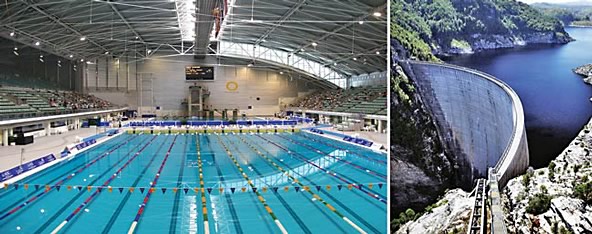When dam size matters
25 October 2012
When you hear about how much water is available in a dam, it is usually expressed in units of megalitres (ML) or gigalitres (GL). One megalitre is equal to one million litres and one gigalitre equals 1000 million litres.
The numbers sound big, but what do they really look like? A standard Olympic-size swimming pool contains 2.5 ML or 2,500,000 litres of water. Sydney Harbour holds about 500 GL.
Australia has about 500 publicly-owned water storages. The largest is Lake Gordon in Tasmania with a capacity of 11,146 GL, enough to fill more than four million Olympic swimming pools or 22 Sydney Harbours.
The next largest is Lake Argyle on the Ord River, Western Australia, with 10,431 GL. Then comes Lake Eucumbene, New South Wales, at 4366 GL (part of the Snowy Mountains scheme); Lake Dartmouth, Victoria, at 3827 GL; and Lake Eildon, Victoria, at 3250 GL.

Left: Sydney Olympic Park Aquatic Centre. A standard Olympic-size swimming pool has 2.5 megalitres of water. Photograph by Lynton Crabb. Right: Lake Gordon, Tasmania. Photograph by Robert T. Wong.


Comment. Tell us what you think of this article.
Share. Tell others.